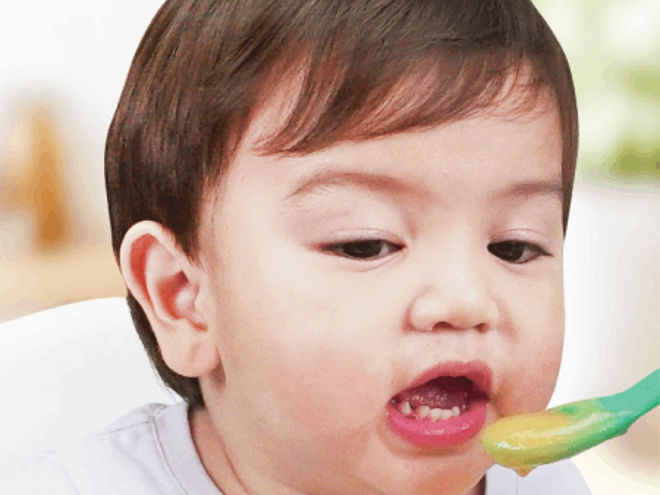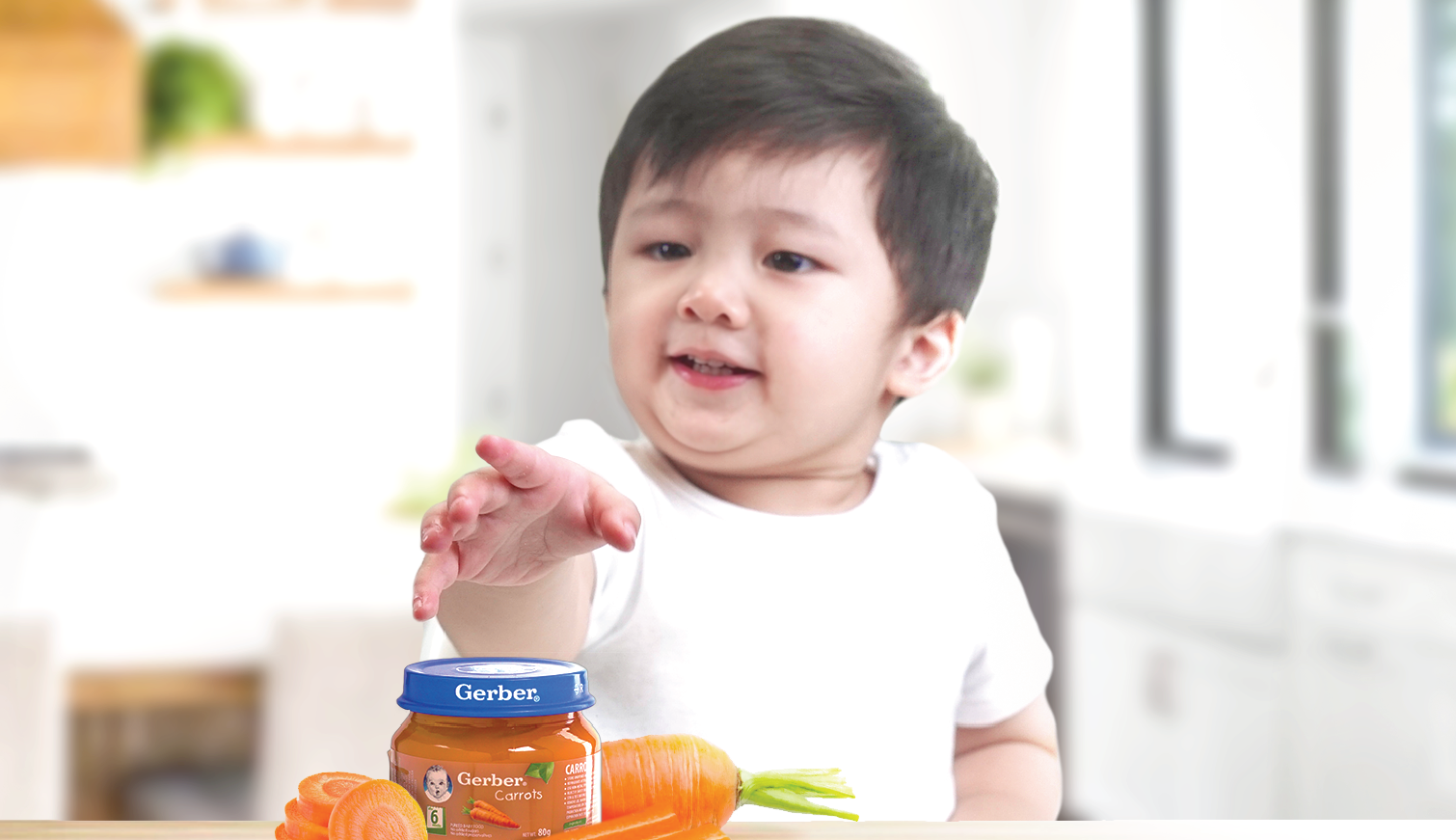
Healthy Eating and Nutrition
Being a parent brings up new questions almost every day—and not knowing where to look can be overwhelming. That's why we've collected what you need to know about hunger and fullness cues, picky eating, spit-up, poop problems, allergies and more. So you know you're finding the answers for your little one.
Is he getting enough?
Along with paying attention to your baby’s growth pattern, your pediatrician will also help you monitor your little one’s growth to help ensure he is eating enough.
Growth check
You might notice at each checkup that your baby’s pediatrician will measure your baby’s length, weight and head circumference, and plot the information on a growth chart. What’s most important is that your baby continues to grow in his own steady way. Don't hesitate to ask your doctor if you have any questions.
Healthy Eating & Nutrition
Nutrition plays an important role in your child's growth and development. Find out how to support healthy eating habits from the beginning and learn more about the nutrients you and your child need at whatever stage you're at now.

Homemade baby food how-tos
Texture and consistency
Your baby food should change as your baby grows. To make baby food that is right for their current milestone, stick to the consistencies below.
• Supported Sitter - Smooth, thin single texture
• Sitter - Thick, coarse single texture
• Crawler - Diced, soft pieces or thick puree with lumps
Making safety your first priority
Babies are at a higher risk of food-borne illnesses because their immune system are not fully developed. Follow the tips below to help ensure your homemade baby food is prepared safely.
• Thoroughly wash your hands and equipment before getting started.
• Wash food well before you begin chopping, even those you plan to peel.
• Use different cutting boards for your meat, poultry, fish and non-meat foods, like fruits and vegetables. Wash knives well between cutting different foods.
• Make sure your refrigerator is set below 4⁰C; (39.2⁰F) and that meats are stored in the coldest part.
• Cook all foods to the correct internal temperature. Minimum cooking temperatures: are as follows: ed meat = 71⁰C (160⁰F), poultry = 74⁰C (165⁰F), pork and fish = 63⁰C (145⁰ F).
Foods to avoid making at home
The American Academy of Pediatrics recommends to only feed commercial preparations of the following baby foods in early infancy: spinach, beets, green beans, squash and carrots. These foods may be high in nitrates, a chemical that can cause a low blood count (anemia) in young babies. Levels of nitrates are tested in commercially-prepared baby foods.
Additionally, the following foods should never be fed to your baby or used in homemade baby foods, since they increase the risk of food-borne illness.
• Unpasteurized dairy foods, like raw milk and many soft cheeses
• Honey
• Home-canned foods
• Food from cans that are dented, rusted, damaged, out-of-date or missing a label
Tips for preparing homemade baby food
• Choose fresh foods first, though frozen and canned foods work as well.
• Prepare foods without salt, sugar or seasoning.
• Stick with single-ingredient foods in the beginning.
• Use a blender, food processor or food mill, following manufacturer’s directions, to puree your baby’s first foods. Machines that both steam and puree are also an option.
• Remember to match the consistency and texture with his developmental stage.
Storing your homemade baby food
• Always throw out any left-over, uneaten food from your baby’s dish.
• Once cooked, baby food should be refrigerated within two hours (or one hour if the outside temperature is more than 320C [90⁰ F]).
• Prepared, homemade baby food can be stored in the refrigerator for 24 hours for meat, poultry, fish, and eggs and 48 hours for fruits and vegetables. It can then be frozen for up to one month.
• Thaw frozen baby foods in the refrigerator or microwave (be careful and watch for hot spots). Never leave food to thaw at room temperature or sitting in water.
Understanding sugar
Natural sugars vs. added sugars
There are two basic types of sugar that can appear in your baby’s diet: sugar that comes from nature and added sugar. A baby’s body can’t tell the difference between them and both kinds of sugars are digested and broken down the same way.
Natural sugars can be found in nutritious foods in your baby’s diet, like fruits, and also in foods you may not think of as “sweet”: milk and milk products, and vegetables. Added sugars, such as brown or white table sugars, syrups, honey, corn syrup and other sweeteners, can be added to foods in your baby’s diet for taste and sometimes to play a role in functions, such as helping foods brown and adding texture.
What's wrong with added sugars?
The problem with too many added sugars in foods in your baby’s diet is that they usually are found in foods with little other nutrition. Plus, foods that have added sugars, such as fruit juice concentrate, softdrinks, cakes, cookies and other sweet desserts, can push more nutritious foods out of your baby’s diet.
Fresh fruit is a great way to give your baby something sweet each day in his diet. Soft, diced fruit or fruit purees are better than sweet desserts since they offer nutrients along with a naturally sweet taste. And don’t forget, too many sugary foods are not healthy for your baby’s teeth!
Check the nutrition fact
To check how much total sugar is in your baby’s food, look for “Sugars” listed on the Nutrition Facts label on packaged foods, under “Total Sugar,"—which represents all the sugar in the product, natural and added. On a separate line you'll see the added sugar on its own.
Read the ingredients
You can also look for added sugars in your baby’s foods by reading the ingredients list. Added sugar goes by many names, including corn syrup, fructose, rice syrup, dextrose, sugar or sucrose, molasses, honey, cane syrup and others. Ingredients are listed in order from the highest to the lowest amounts, so if you see these or other added sugars at the top of the list that means the product has a large amount of added sugar.
References:
1. Young B, et al. Complementary Feeding: Critical Considerations to Optimize Growth, Nutrition, and Feeding Behavior. Curr Pediatr Rep. 2013 Dec 1; 1(4): 247–256.
2. Denney L, Angeles-Agdeppa I, et al. Nutrient Intakes and Food Sources of Filipino Infants, Toddlers and Young Children are Inadequate: Findings from the National Nutrition Survey 2013. Nutrients 2018;10: 1730.
3. Scaglioni S, et al. Influence of parental attitudes in the development of children eating behaviour. Br J Nutr 2008;99 Suppl 1:S22-25.
4. Paroche MM, et al. How Infants and Young Children Learn About Food: A Systematic Review. Front Psychol. 2017; 8: 1046.
5. USDA Food Safety and Inspection Service resources page. Safe Minimum Internal Temperature Chart [Internet]. 2020 May 11 [cited 2020 Aug 31]. Available from: https://www.fsis.usda.gov/safetempchart.
6. Greeg FR, et al. Infant Methemoglobinemia: The Role of Dietary Nitrate in Food and Water. Pediatrics. 2005;116(3):784. Available from: https://pediatrics.aappublications.org/content/pediatrics/116/3/784.ful…









